Content:
The homeland of eggplants is India. They are grown not only in countries where the climate is warm, but also where it is temperate. Eggplants belong to the nightshade family, that is, they are relatives of tomatoes and potatoes.
Agricultural technology of cultivation
In the weather conditions of central Russia, they are grown using seedlings. The period during which it is possible to prepare it is from 60 to 70 days. Germination of eggplant seeds occurs 7-12 days after planting.
It is recommended to choose early maturing varieties for growing. For planting in a greenhouse, you need to prepare seedlings:
- First you need to prepare the ground. It is a mixture of turf, peat and humus. Additionally, wood ash is usually added along with superphosphate. It makes sense to add sawdust. This product will make the soil looser.
- You can plant in peat or plastic cups, as well as in boxes or special cassettes.
- When sowing, put one seed at a time in a hole to a depth of one and a half centimeters. The distance between them is set at 3 cm. If the seedlings are grown in cups, then one seed is placed in each.
- After sowing, the plants are covered with foil and placed in a warm place.
- During cultivation, the temperature should be between 25 and 30 degrees. If it happens that the temperature is below 13 degrees, then the seeds will not germinate.
- It is permissible to use yeast to feed the seedlings.
- The quality of irrigation is of great importance. When growing seedlings, it is necessary to ensure that the soil does not dry out. Watering is allowed only with warm water.
- It is worth paying attention to proper lighting. As soon as shoots appear, you need to transfer the boxes with seedlings to a well-lit place. In this case, it is necessary to equip it in such a way that direct sunlight does not fall on the sprouts.
- During the first week after sprouting, a slightly lower temperature should be provided. It should be between 14 and 16 degrees. This is to prevent over-stretching of the sprouts.
- In the following weeks, the temperature is increased. It should now be between 18-25 degrees.
- It is important to ensure that there is no excessive moisture in the soil. Otherwise, the risk of bad consequences - black leg infection - increases.
When the first leaves appear, the seedlings are watered, every second seedling is transplanted into another box (it must be prepared in advance). As a result, every second leaf should remain in place, and in the new box they will be located at twice the distance than before. The distance should be 4-5 centimeters.
Additionally, it is customary to carry out additional lighting of seedlings. Its purpose is to provide conditions under which the duration of lighting of seedlings in greenhouse conditions is at least 12 hours a day.
Quenching is recommended. To do this, at first, you need to provide a temperature of 15 degrees for two hours. Then this period should be gradually increased.
Good predecessors in this case would be:
- cabbage;
- bow;
- cucumbers;
- legumes;
- carrot;
- melons and gourds.
It is best to choose a site with sandy loam or sandy soil. It will be nice if there is a lot of humus in it.
Eggplants love soil that warms up easily in spring.
It is also desirable that the place where they are planted has protection from the cold northerly winds. If the soil is damp and heavy, it is completely unsuitable for planting eggplants.
Seedlings are planted in open ground when there is no more frost.
Why feed eggplants
When grown in a polycarbonate greenhouse, they need a fairly high temperature. The most comfortable for them is 25-28 degrees.
Popular experience says that these plants respond well to feeding with organic fertilizers.
Top dressing is necessary for various purposes:
- When eggplants have enough nutrients, it helps them grow to their full potential, become plump, tasty, and produce a good harvest. But the excessive presence of chemical fertilizers is undesirable, therefore it is better to combine them with organic feeding.
- Sometimes eggplants do not grow well when there is a lack of nutrition. To combat this, you need to feed the eggplant in the greenhouse. In addition, the stores sell formulations that stimulate plant growth. You also need to remember about the need to trim plants. If you do not do it, this will lead to the formation of small and tasteless fruits.
- Fighting disease requires feeding. The plant needs to create comfortable conditions. If necessary, it is necessary to spray with disinfectant solutions.
How to properly feed eggplants
It will tell you how to feed the eggplant after planting it in the greenhouse. For each square meter, it is recommended to make:
- from 5 to 7 kilograms of humus;
- in the fall, before plowing the area, you will need 25-30 grams of superphosphate;
- in the fall, at the same time, you need 25-30 grams of potassium sulfate;
- during spring tillage, 15-20 grams of urea should be added.
At first, phosphorus-potassium fertilizers are used. And during the fruiting period, nitrogen-phosphate is used.
How you can feed eggplants in a greenhouse:
- The first time fertilization is applied 2 or 3 weeks after planting the seedlings. This is done in order to give time to the roots to take root in a new soil for them. At the same time, a mixture of nitrogen, potassium and phosphorus fertilizers is prepared, 10 grams per bucket of water. This is how the eggplant is fed after planting in the greenhouse.
- If the eggplants have poor flowering, they are sprayed with a boric acid solution.
- It is important to control the feeding process so that there is no overuse of chemical fertilizers. For this purpose, it is recommended to fertilize the plants with mullein and fermented grass. You can also use eggplant ash.
- When young eggplants grow too slowly, it is recommended to spray them with Bud or Ovary solutions. Moreover, as soon as the eggplant reaches a height of 30 centimeters, the upper point of growth is pinched off.
- It is recommended to leave no more than 7-10 ovaries on one bush.
- When the period comes, and they are able to tie, do another top dressing. It is recommended that it be twice as large as it was in the spring. Fertilization with organic fertilizers is permitted instead.
- The third feeding is done in the same way as the second. Its time comes when the fruits begin to form. After that, it is repeated every 15 days throughout the entire fruiting period. In this case, fertilizers are poured under the roots of the bushes.
You need to know if eggplants like ash. It is an organic fertilizer that can be regularly used to feed eggplants.
Experienced gardening tips
Some tips for eggplant growers:
- When transplanting seedlings, the roots must be moved with the ground, otherwise they can be damaged.
- Given the long ripening period of eggplants, it is recommended to use the earliest ripening varieties in central Russia.
- In the greenhouse for this plant, you need to provide warm conditions. However, excessive moisture should not be allowed. To do this, you need to regularly ventilate.
- You need to water it regularly, but this is allowed only with warm water.
- Eggplant ash is one good feeding method. You can also use ammonia with a high nitrogen content.
Eggplant is a difficult crop to grow, so top dressing is a must for a good harvest. Proper care is a guarantee of eggplant productivity and health.


















